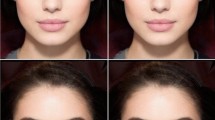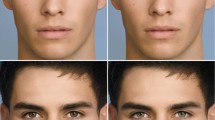Abstract
Even after they have taken all reasonable measures to decrease the probability that their spouses cheat on them, men still face paternal uncertainty. Such uncertainty can lead to paternal disinvestment, which reduces the children’s probability to survive and reproduce, and thus the reproductive success of the fathers themselves. A theoretical model shows that, other things being equal, men who feel confident that they have fathered their spouses’ offspring tend to enjoy greater fitness (i.e., leave a larger number of surviving progeny) than men who do not. This implies that fathers should benefit from exaggerating paternal resemblance. We argue that the self-deceiving component of this bias could be concealed by generalizing this resemblance estimation boost to (1) family pairs other than father-child and (2) strangers. Here, we tested the prediction that fathers may see, in unrelated children’s faces, stronger family resemblances than non-fathers. In Study 1, 70 men and 70 women estimated facial resemblances between children paired, at three different ages (as infants, children, and adolescents), either to themselves or to their parents. In Study 2, 70 men and 70 women guessed the true parents of the same children among a set of adults. Men who were fathers reported stronger similarities between faces than non-fathers, mothers, and non-mothers did, but were no better at identifying childrens’ real parents. We suggest that, in fathers, processing of facial resemblances is biased in a manner that reflects their (adaptive) wishful thinking that fathers and children are related.





Similar content being viewed by others
References
Anderson, K. G. (2006). How well does paternity confidence match actual paternity? Evidence from worldwide nonpaternity rates. Current Anthropology, 47, 513–520.
Apicella, C. L., & Marlowe, F. W. (2004). Perceived mate fidelity and paternal resemblance predict men’s investment in children. Evolution and Human Behavior, 25, 371–378.
Bellini, A. (2003). Like father, like son: The perception of family resemblances in an evolutionary perspective. Unpublished master’s thesis, University of Padua, Padua, Italy.
Brédart, S., & French, R. M. (1999). Do babies resemble their fathers more than their mothers? A failure to replicate Christenfeld and Hill (1995). Evolution and Human Behavior, 20, 129–135.
Bressan, P. (2002). Why babies look like their daddies: Paternity uncertainty and the evolution of self-deception in evaluating family resemblance. Acta Ethologica, 4, 113–118.
Bressan, P., & Dal Martello, M. F. (2002). Talis pater, talis filius: Perceived resemblance and the belief in genetic relatedness. Psychological Science, 13, 213–218.
Bressan, P., & Grassi, M. (2004). Parental resemblance in one-year-olds and the Gaussian curve. Evolution & Human Behavior, 25, 133–141.
Bressan, P., & Stranieri, D. (2008). The best men are (not always) already taken: Female preference for single versus attached males depends on conception risk. Psychological Science, 19, 145–151.
Cohen, J. (1988). Statistical power analysis for the behavioral sciences (2nd ed.). Hillsdale, NJ: Erlbaum.
Gaulin, S. J. C., & Schlegel, A. (1980). Paternal confidence and paternal investment: A cross cultural test of a sociobiological hypothesis. Ethology and Sociobiology, 1, 301–309.
Geary, D. C. (2000). Evolution and proximate expression of human paternal investment. Psychological Bulletin, 126, 55–77.
Kaminski, G., Dridi, S., Graff, C., & Gentaz, E. (2009). Human ability to detect kinship in strangers’ faces: effects of the degree of relatedness. Proceedings of the Royal Society, Series B, 276, 3193–3200.
Little, A. C., Jones, B. C., Penton-Voak, I. S., Burt, D. M., & Perrett, D. I. (2002). Partnership status and the temporal context of relationships influence human female preferences for sexual dimorphism in male face shape. Proceedings of the Royal Society, Series B, 269, 1095–1103.
McLain, D. K., Setters, D., Moulton, M. P., & Pratt, A. E. (2000). Ascription of resemblance of newborns by parents and nonrelatives. Evolution and Human Behavior, 21, 11–23.
Nesse, R. M., Silverman, A., & Bortz, A. (1990). Sex differences in ability to recognize family resemblance. Ethology and Sociobiology, 11, 11–21.
Oda, R., Matsumoto-Oda, A., & Kurashima, O. (2005). Effects of belief in genetic relatedness on resemblance judgments by Japanese raters. Evolution and Human Behavior, 26, 441–450.
Pagel, M. (1997). Desperately concealing father: A theory of parent-infant resemblance. Animal Behavior, 53, 973–981.
Trivers, R. (1985). Social evolution. Menlo Park, CA: Benjamin/Cummings.
Volk, A., & Quinsey, V. L. (2002). The influence of infant facial cues on adoption preferences. Human Nature, 13, 437–455.
von Hippel, W., & Trivers, R. (2011). The evolution and psychology of self-deception. Behavioral and Brain Sciences, 34, 1–16.
Author information
Authors and Affiliations
Corresponding author
Rights and permissions
About this article
Cite this article
Bressan, P., Dal Pos, S. Fathers See Stronger Family Resemblances than Non-Fathers in Unrelated Children’s Faces. Arch Sex Behav 41, 1423–1430 (2012). https://doi.org/10.1007/s10508-012-9983-x
Received:
Revised:
Accepted:
Published:
Issue Date:
DOI: https://doi.org/10.1007/s10508-012-9983-x




